|
Category
|
Buddhist monuments of Termez: Cave Monastery Karatepa. Fayaztepa Monastery. Stupa Zurmala.The history of international relations of East and West along the Silk Road has deep roots and is full of fascinating stories. This is an ancient caravan route promoted not only trade but also the interpenetration of cultures of different nations. It was on the Silk Road in early AD, to the territory of Uzbekistan from India penetrated Buddhism. Hence, it is one of the oldest religions of the world moved on - to China, Korea and Japan.
Among other information, Xuan Jiang reported that in the Principality of Ta-mi - that is in Tarmita, as in ancient times was called the city of Termez, - he found a dozen monasteries and about a thousand monks, sacred Buddhist monuments "stupa" and, finally, the numerous statues of the Buddha. In the middle of the XIX century, it all seemed surprising and low fidelity. However, in the early 80s of the XIX century geologist J. Mushketov wrote about the caves in the loess cliff near Samarkand, is very similar to the cave monasteries of India. There, in Samarkand, orientalist N.I. Veselovsky bought some Buddhist idols very ancient origin. A few years later began the opening of Buddhist sculpture and painting in the oases of Eastern Turkestan. Since the late 90s of the XIX century the southern lands of Bukharian khanate, which included Termez, captured the true archaeological fever: search for antiquities involved in archaeologists and local lovers of antiques, and just treasure hunters. Gradually, finds some way supporting information Xuan Jiang, accumulating more and more. The first Buddhist temple in Uzbekistan has been found by archaeologists in the area Airtam on the bank of the Amu Darya River. Scientific research conducted here M.Masson discovered in 1932 by some great Buddhist statues and plates depicting musicians and garland bearers. Cave Monastery Karatepa
In autumn 1961 on a hill Karatepa began excavations under the direction of archaeologist B.Ya.Staviskiy. Before that, he excavated the city, buried in the loess hills near Samarkand, castles and secluded in the mountains Zeravshan Ridge, drove more than one hundred miles in pursuit of the ghost of the Kushan culture, each segment of this path led steadily to the south, to the shores of the Amu Darya in Tarmita.
The threshold has opened a small room. In the courtyard, archaeologists have found fragments of statues, large as a man. The long vaulted corridors, fragments of bowls, jugs, lots of lights - oil bowls with flattened nose for a wick - everything suggests the harsh life of a monk, a meager meal at the table, the night prayers in the twilight flicker. On the fixtures remained one and a half millennia soot. 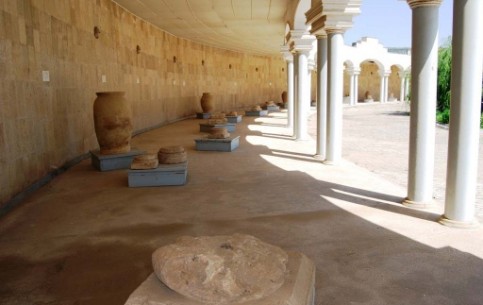 As a result of excavation Stavisky was found that on Karatepa there was no a only temple or monastery, and a Buddhist complex - a system of temples. In addition, the findings on Karatepa stated their age-old Bactrian origin with such certainty, as if standing on each stamp: "Made in Bactria." Sculpture and colorful designs, the very architecture of the temples Tarmita - all rooted in the ancient local traditions. Bactrian art school as a whole, together with the famous Gandhara school in India participated in the creation of art of early Buddhism, which left an indelible mark in the history of world culture. It is an art long do without the image of the Buddha. His presence represents a character. For example, the wheel - his first sermon, the beginning of exercise. A woman on a lotus and the elephant on her - the birth of Buddha. Bareback symbolized great care when Prince Gautama left his palace, his wife, son, and left to wander the Indian roads in search of truth.
Buddhist Art - a vast art world, immense number of works, polysyllabic on their composition and origin. All the more astonishing idea that art is evolved within the Kushan culture was part of it. The fate of Buddhism intertwined with the fate of the Kushan state. Buddhist monastery Fayaztepa
Buddhist complex Fayaztepa was first found and investigated by archaeologist L. Albaum. The modern name of the monument was formed from the surname of the director of Surkhandarya Regional Museum, R.F. Fayazov, who has been a great help to archaeologists in 1968, when excavations were initiated here. This monument is located near the ancient city Tarmita. The complex covers an area of 117*34 m. It is located between the Amu Darya and the ancient caravan route.
Also, according to the irrigation water on the Fayaztepa there - the water was fed into the temple at 2.5 km long aqueduct.
Excellent Buddhist sculptures found during the excavations, depicting the Buddha, Bodhisattvas and the tops of the characters of the Kushan state, enriched the treasury of the ancient sites of Uzbekistan. It was here that archaeologists discovered the amazing beauty of the statue of Buddha with two monks - the famous "Triad", now decorating the exhibition of the Museum of History of Uzbekistan in Tashkent. The final stage of a large archaeological work carried out in the temple-monastery complex Fayaztepa for forty years, was the discovery of this research center for its study. In recent years, many complex and fruitful joint work of the Uzbek-Japanese expedition led by E. Rtveladze and Kyudzo Kato. Given its historic importance for the study of Buddhist era, the Ministry of Culture and Sports of the Republic of Uzbekistan, UNESCO, the Foundation "Trust" from Japan provided a grant to carry out works on the restoration and preservation of the object. And after the restoration work carried out during 2004 - 2006 period, the complex Fayaztepa turned into an outdoor museum. Buddhist stupa Zurmala
The tower was hit hard from time to time, however, it produces an impressive impression. Stupa laid out a square from adobe bricks. All the bricks have the characteristic features of the stigma in the form and the two pits. These bricks were used in Bactria only in the Kushan period, ie at the beginning of the III c. Scientists estimate that the erection of the stupa took nearly 1.2 million of these bricks. The continuous array of adobe brick is at the top of a small chamber for relics - relic. Cylindrical body of the stupa stands 14.5 meters in diameter by 13 meters above the ground. Stupa is one of the most important and ancient Buddhist symbols. The most ancient stupas, and applies to them and the stupa Zurmala, were built of brick and stone hemisphere. Their appearance dates back to ancient burial hills - mounds and symbolized "Parinirvana" - Buddha's death and his burial. Incidentally, the word "stupa" in Sanskrit literally means "a lot of earth or stones." Another important purpose of the stupa - the repository of Buddhist relics. In the first centuries after Buddha's death in a cube-shaped box, so-called "God's house", laid a lock of hair from the head of Buddha, the piece of cloth from his clothes, some of his imperishable relics. Later, as the relics kept the precious metals and stones, seeds - symbols of God and the divine power. The reliquary was placed on top of the stupa. Above it rose a rod topped with a decreasing up umbrellas. Umbrella - a symbol of nobility of man's origin. As you know, Siddharth Gautama, the founder of the theory, receiving the nickname Buddha - the "enlightened", the prince was the son of the north-eastern India. And since the Buddha was seen not only as a faithful spiritual leader, but as the king of the gods and the universe, then the stupa in honor of Teacher of the supreme power was placed a few umbrellas. The rod and umbrellas on the Stupa, of course, have not survived, but the wall paintings of the Buddhist cave temple Karatepa, located nearby, on the site of Old Termez, provides insights about the design of Bactrian stupas. Typically, this step three-tiered tower with a dome termination, which is hoisted on the top bar with "umbrellas of honor." Based on the analysis of the proportions of the mortar, archaeologists have come to the conclusion that the original appearance of the tower Zurmala was close to these images. Stupa near the Old Termez was the first Buddhist building, opened in Central Asia. Today there are about forty, and two dozen Buddhist monuments in the territory of Uzbekistan. In preparing the articles used material of the magazine "Around the World" and the sites http://www.vokrugsveta.ru, http://mcs.uz (Ministry of Culture and Sports of Uzbekistan). |
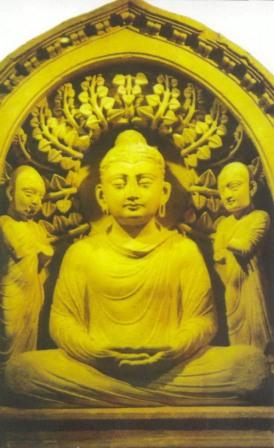 In the middle of the XIX century, Stanislas Julien, a philologist of the College de France in Paris, translated into French a book of Buddhist monk Xuan-chiang, who visited in 630's of our era, the country's north-west of the Hindu Kush and the headwaters of the Amu Darya River. Xuan Jiang said in her Chinese and Japanese on the prosperous country Sogdiana, Samarkand, his capital, reported Chach (Tashkent), the Ferghana Valley, Ustrushana, Kesh and Bactria. The book of the traveler and pilgrim became a scientific sensation. Not that his “Description of the Western countries” brightness geography of the areas of East, where in 1850 visited a few Europeans - was unexpected by history itself of these places. It appeared, for instance, that Buddhism flourished here until the adoption of Islam in the late VII century AD.
In the middle of the XIX century, Stanislas Julien, a philologist of the College de France in Paris, translated into French a book of Buddhist monk Xuan-chiang, who visited in 630's of our era, the country's north-west of the Hindu Kush and the headwaters of the Amu Darya River. Xuan Jiang said in her Chinese and Japanese on the prosperous country Sogdiana, Samarkand, his capital, reported Chach (Tashkent), the Ferghana Valley, Ustrushana, Kesh and Bactria. The book of the traveler and pilgrim became a scientific sensation. Not that his “Description of the Western countries” brightness geography of the areas of East, where in 1850 visited a few Europeans - was unexpected by history itself of these places. It appeared, for instance, that Buddhism flourished here until the adoption of Islam in the late VII century AD.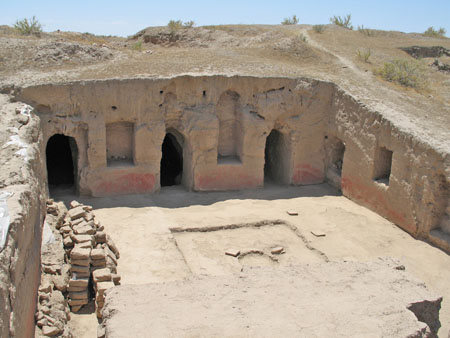 In 1928, historian and critic A.S. Strelkov opened a few caves in the hillside sloping hill Karatepa (in Uzbek "Black Hill") near Termez, on the banks of the Amu Darya. The caves were clogged with sand and rubble of adobe bricks. The bricks are large, square, out of unfired clay, used here long before the Arab conquest, and no later than VII-VIII centuries AD.
In 1928, historian and critic A.S. Strelkov opened a few caves in the hillside sloping hill Karatepa (in Uzbek "Black Hill") near Termez, on the banks of the Amu Darya. The caves were clogged with sand and rubble of adobe bricks. The bricks are large, square, out of unfired clay, used here long before the Arab conquest, and no later than VII-VIII centuries AD.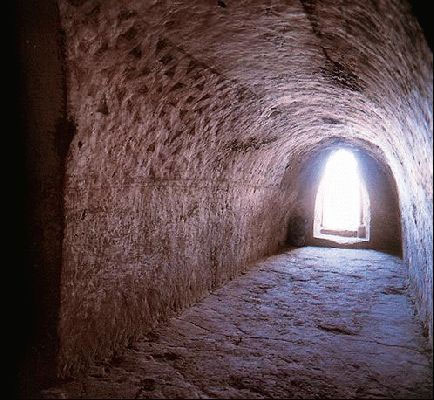 During excavations in Karatepa discovered entrances to the underground churches, littered with boulders and sand. In the analysis of debris in the mountains of rubble and brick medley came across the broken reliefs, ceramic shards, sometimes coins. It took three seasons to clear several caves and a square yard. As he lay stone base of the perimeter columns, round, square on the grounds. Maintained a smooth bright red plaster on the walls of the courtyard, walkway tiles on the floor of the white limestone and high white stone threshold, at which sixteen hundred years ago, someone painted a black outline two unopened lotus.
During excavations in Karatepa discovered entrances to the underground churches, littered with boulders and sand. In the analysis of debris in the mountains of rubble and brick medley came across the broken reliefs, ceramic shards, sometimes coins. It took three seasons to clear several caves and a square yard. As he lay stone base of the perimeter columns, round, square on the grounds. Maintained a smooth bright red plaster on the walls of the courtyard, walkway tiles on the floor of the white limestone and high white stone threshold, at which sixteen hundred years ago, someone painted a black outline two unopened lotus.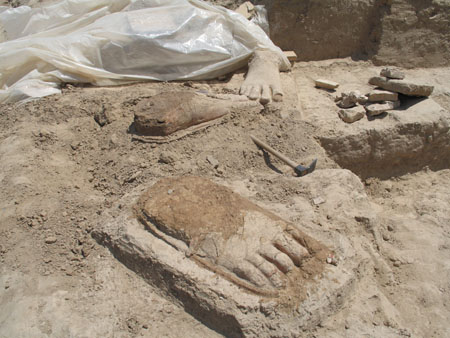 Especially remarkable discovery, made on Karatepa - a fragment of wall painting "Buddha and the monks." The painting had once fallen from the wall, and the top hit clay, gravel, sand, but she did not shattered into a thousand pieces, but only went cracks, having lain under the weight of the dam seventeen or eighteen centuries. In painting the image of the Buddha - expression of detached meditation on youthful face, the traditional absent smile. But this is not a psychological portrait. It is not a person, but only mask the higher understanding, which, according to Buddhism, it should be pursued. The mask is the same conventional, as signs of the greatness of the Buddha - the ledge on the crown, third eye between the eyebrows, elongated earlobes, and the same token, a blue background, white halo around his head, a halo of white, covering the entire figure. Thus was created the canonical image of the Buddha, and so gradually disappeared in the fog of symbols, metaphors, symbols and memories of a traveling philosopher, the brave wise man, who said: "The poor and lowly, the rich and the nobles - all equal".
Especially remarkable discovery, made on Karatepa - a fragment of wall painting "Buddha and the monks." The painting had once fallen from the wall, and the top hit clay, gravel, sand, but she did not shattered into a thousand pieces, but only went cracks, having lain under the weight of the dam seventeen or eighteen centuries. In painting the image of the Buddha - expression of detached meditation on youthful face, the traditional absent smile. But this is not a psychological portrait. It is not a person, but only mask the higher understanding, which, according to Buddhism, it should be pursued. The mask is the same conventional, as signs of the greatness of the Buddha - the ledge on the crown, third eye between the eyebrows, elongated earlobes, and the same token, a blue background, white halo around his head, a halo of white, covering the entire figure. Thus was created the canonical image of the Buddha, and so gradually disappeared in the fog of symbols, metaphors, symbols and memories of a traveling philosopher, the brave wise man, who said: "The poor and lowly, the rich and the nobles - all equal".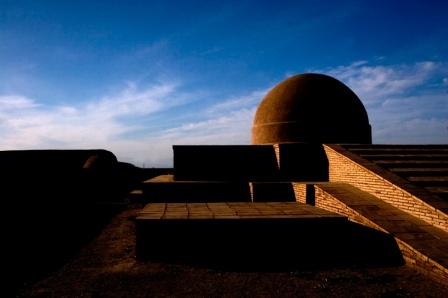 Since the turn of our era in Northern Bactria around Tarmita raises a number of Buddhist religious monuments in the north-west a large cave center Karatepa, in the north - temple-monastery complex Fayaztepa, in the east, near the walls of the ancient citadel - the mound, on the surface of which are found fragments of Buddhist sculpture, further to the east - a “stupa”, now known as the "Tower Zurmala" and others.
Since the turn of our era in Northern Bactria around Tarmita raises a number of Buddhist religious monuments in the north-west a large cave center Karatepa, in the north - temple-monastery complex Fayaztepa, in the east, near the walls of the ancient citadel - the mound, on the surface of which are found fragments of Buddhist sculpture, further to the east - a “stupa”, now known as the "Tower Zurmala" and others.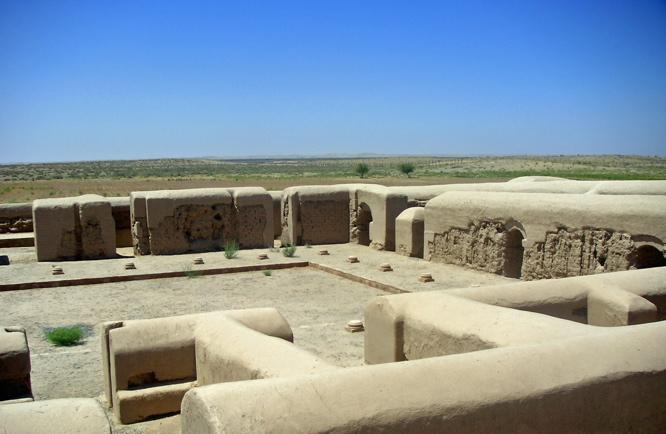 This grand structure clearly divided into three parts: the chu rch, convent and outbuildings of the refectory. Each of them consists of a courtyard and located around the premises. Apart from the main body on special pedestal erected a stupa with a perfectly round dome. It belongs to the I c. BC and is considered the oldest building of the complex within which it is hidden symmetric, but smaller in size - only 2.8 meters in diameter. The central part of the complex consists of a courtyard, which is located on the perimeter of the room, and adjacent to them aivan. Walls aivan gallery, resting on a number of columns, decorated from top to bottom color images. By hypothesis, archeologists, there was a temple. The northwestern part of the complex is a complex layout of the monastery. In his small-sided indoor courtyard located aiwan and monks' cells.
This grand structure clearly divided into three parts: the chu rch, convent and outbuildings of the refectory. Each of them consists of a courtyard and located around the premises. Apart from the main body on special pedestal erected a stupa with a perfectly round dome. It belongs to the I c. BC and is considered the oldest building of the complex within which it is hidden symmetric, but smaller in size - only 2.8 meters in diameter. The central part of the complex consists of a courtyard, which is located on the perimeter of the room, and adjacent to them aivan. Walls aivan gallery, resting on a number of columns, decorated from top to bottom color images. By hypothesis, archeologists, there was a temple. The northwestern part of the complex is a complex layout of the monastery. In his small-sided indoor courtyard located aiwan and monks' cells.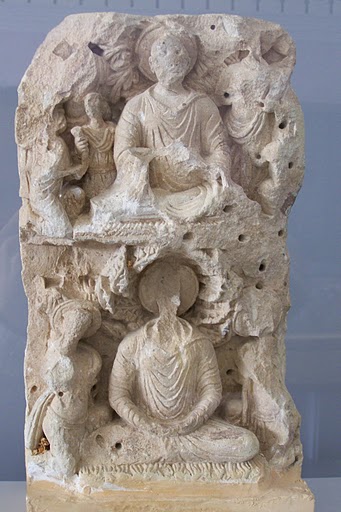 Time of construction of the monastery is considered to be the second half of I c. BC.
Time of construction of the monastery is considered to be the second half of I c. BC.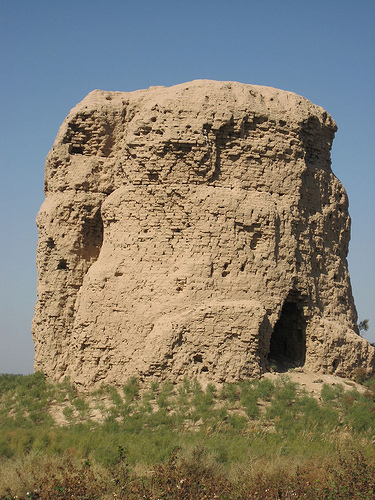 To the south-east of the settlement of Old Termez on the side of the road leading to the modern Termez, towering remains of buildings, known as Tower Zurmala. The ruins of the tower has long attracted the attention of archaeologists. Back in 1926, they suggested that this is nothing but a Buddhist stupa. A detailed survey conducted half a century later, confirmed that a religious structure, referring to the era of prosperity of the Kushan Empire.
To the south-east of the settlement of Old Termez on the side of the road leading to the modern Termez, towering remains of buildings, known as Tower Zurmala. The ruins of the tower has long attracted the attention of archaeologists. Back in 1926, they suggested that this is nothing but a Buddhist stupa. A detailed survey conducted half a century later, confirmed that a religious structure, referring to the era of prosperity of the Kushan Empire.














